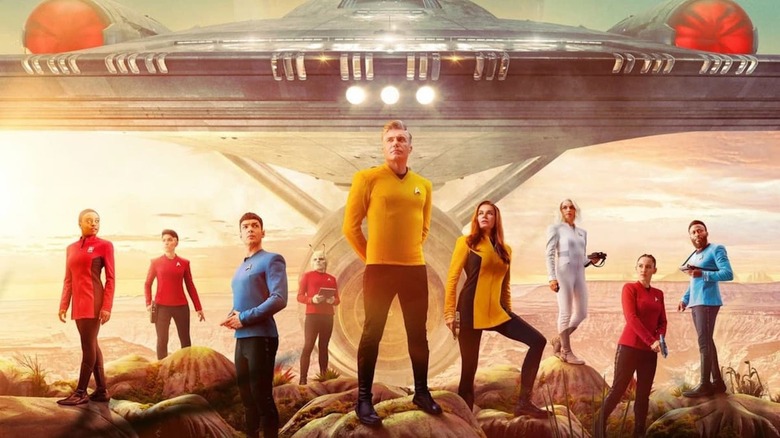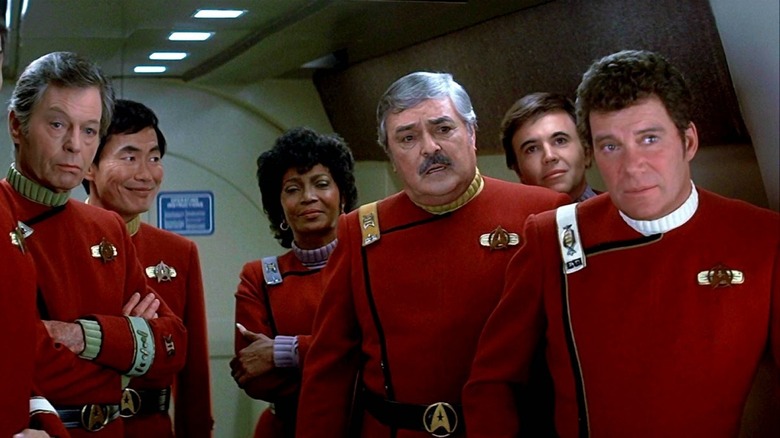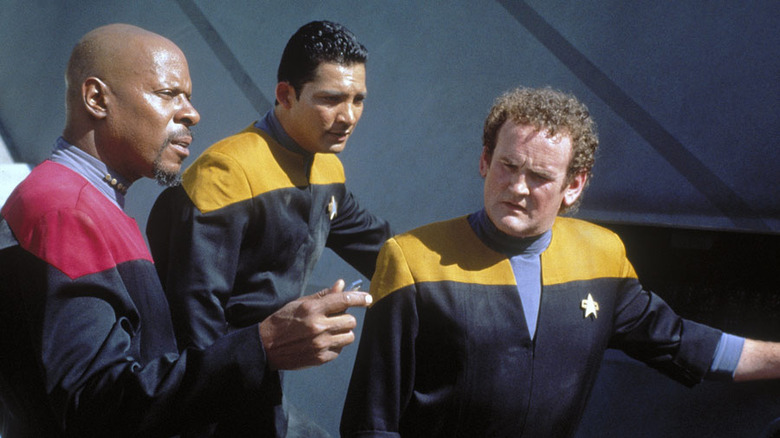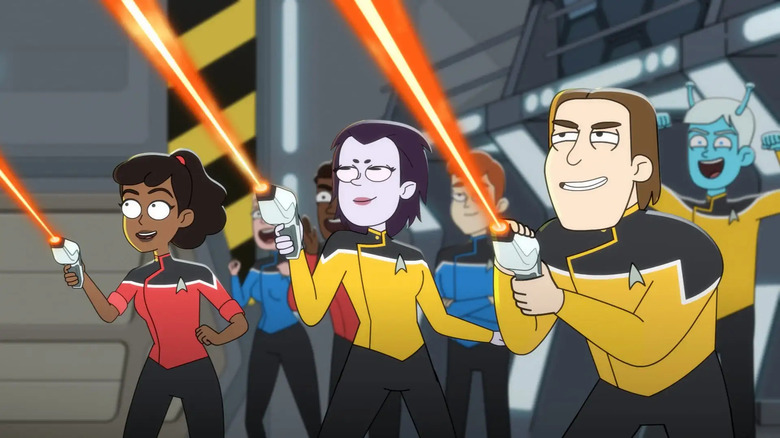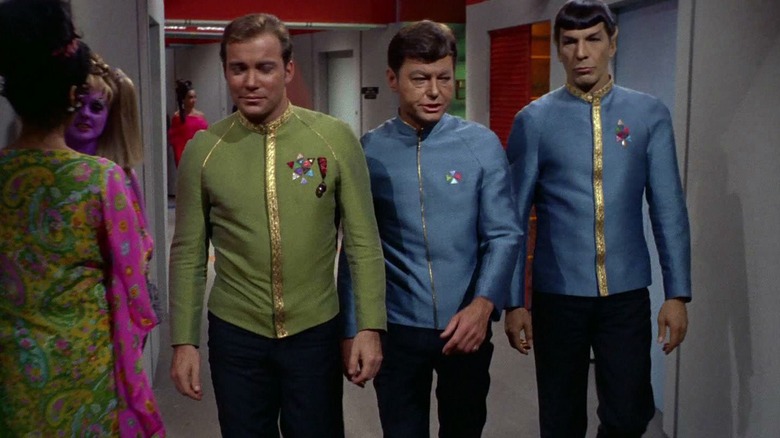Why Star Trek's Ever-Changing Uniforms Are More Than Just Style Choices
This post contains spoilers for the season finale of "Star Trek: Strange New Worlds."
The first-season finale of "Star Trek: Strange New Worlds," called "A Quality of Mercy," arrived on Paramount+ today, ending what may be the finest first season in "Star Trek" history (Trek shows all notoriously get off to rocky starts). The final episode, rife with fan service, sees Captain Pike (Anson Mount) confronting his future self and visiting the "Original Series" era via a magical widget called a Klingon time crystal. Pike's future self — coming from a timeline where a great Romulan war is raging — offers present-day Pike an opportunity to visit a period seven years hence where he will have the opportunity to prevent said war from ever starting. As it so happens, that period is the original "Star Trek" episode "Balance of Terror" from 1966, only with Pike serving as captain instead of Kirk (It should be noted that "Strange New Worlds" takes place nearly a decade prior to the events of "Star Trek").
When Future Pike arrives to tell Present Pike about the possibility of a future timeline, he appears in a red nautical uniform with a pull-across breast flap, an over-the-shoulder clasp, and a small, white collar. This is the uniform first seen in "Star Trek II: The Wrath of Khan," and which persisted throughout the following four Trek feature films. The uniform was a chronology-appropriate reference to the way Starfleet uniforms change over time, and was an instant indicator — in addition to Anson Mount's age make-up — of when exactly this new Pike was visiting from.
The frequent rotating of uniforms
Sticklers for continuity — and all good Trekkies are likely sticklers for continuity — might point out that the frequent changes of uniform may not make a lot of sense for a military organization like Starfleet. Starfleet is frequently depicted as being devoted to order and fostering its crew's esprit de corps, and devotion to a certain orderly status quo is one of the tenets of the organization.
It's jarring to a Trekkie's eye to see multiple kinds of uniforms occupying the same bridge at any given moment. In the original "Star Trek," the female officers wore miniskirt uniforms, a sexist trope that "Next Generation" tried to take the curse off of by depicting male officers wearing them as well. While the effort was appreciated, it was too little too late, and a universal uniform was eventually settled on. Especially jarring was the mixture of uniforms seen in the 1994 film "Star Trek: Generations" which featured several characters wearing the color-coded departmental uniforms as they appeared on "Next Generation," but several others wearing the colored-shoulder-grey-turtleneck uniforms that first appeared on "Star Trek: Deep Space Nine." Did "Generations" take place during a strange, brief transitionary period in Starfleet when either uniform was okay?
The changes in uniform, while perhaps the most logical thing in terms of continuity, do make sense from a dramatic perspective: A viewer will be able to tell at a single glance what era the characters are living in. Pike wearing a uniform from the classic movies immediately communicates to the uninitiated that he is from a time far away enough for the uniforms to have changed, and to the initiated that he is from close to 27 years in the future when "Wrath of Khan" takes place.
Keeping it all straight
Ever since the debut of "Star Trek: Deep Space Nine" in 1993, it became acceptable for multiple "Star Trek" shows to run simultaneously. "Deep Space Nine" overlapped with "Star Trek: The Next Generation" for a time, and then shared "Star Trek: Voyager" airspace for multiple seasons. Since Trek is largely about Starfleet, military vessels, and people in uniform ("Star Trek" is, above all, a workplace show), all the characters in any series have to wear the same thing, especially if they take place in the same timeline the way NextGen, DS9, and "Voyager" did. However, in order to distinguish the three shows, the uniforms were slightly different.
The NextGen uniforms were the standard, with the DS9 uniforms appearing to be assignment-based; perhaps deep space assignments warranted a new look. The USS Voyager took on that look, and DS9 changed to a uniform with grey shoulders and department-colored collars. The grey-shoulder look would also carry into future NextGen movies. "Voyager" kept the grey-neck look throughout its run, as they were 75 years away from home and couldn't get the orders to change outfits.
With only the three active Trek shows/movie series running, the uniform shifts were easy to track. This has become more difficult in the Paramount+ era, when the franchise's timelines are splayed all over Trek continuity, and there are more shows than ever shows running simultaneously.
Seven at once
To establish something of a brief timeline of the newer Trek programs: the first two seasons of "Star Trek: Discovery" take place about a decade prior to "Star Trek." "Star Trek: Strange New Worlds" takes place immediately after the second season of "Discovery." Meanwhile, "Star Trek: Lower Decks" takes place after the events of the 2002 movie "Star Trek: Nemesis," and characters from NextGen appear regularly. The first season of "Star Trek: Prodigy" takes place concurrently with the third season of "Lower Decks." "Star Trek: Picard" takes place about 18 years after "Prodigy." Then, just to muddy the waters further, the third and fourth seasons of "Discovery" take place in the distant 32nd century.
Now that no one is confused, let us move on.
Looking over the above list, there would need to be seven distinct looks invented. One for each era of Starfleet, and for each notable ship (it's been established that some ships wear different uniforms than others, again presumably as a way to denote the nature of their assignments). The USS Discovery began with blue/silver jumpsuits and boots, and had to change into a new era's uniforms when arriving in the distant future. "Strange New Worlds" features a subtle update of the 1966 uniforms (and even then, were updated slightly from their initial appearance on "Discovery"). The crew of the USS Cerritos on "Lower Decks" wear a NextGen-adjacent look, while the teens on the USS Protostar in "Prodigy" have something more akin to Pike's "Khan"-era uniform. "Star Trek: Picard" mostly takes place out of Starfleet's purview, so the uniforms aren't as common, giving the show its own unique, civilian look.
And none of this addresses formal uniforms, standard athletic uniforms, away mission jackets, medical uniforms, etc. etc. etc.
Across the centuries
The above breakdown of "Star Trek's" timeline reveals that Trek, unlike other sci-fi franchises, offers a very distinct, recorded history and chronology. "Star Wars" fashion, in contrast, seems to be weirdly stable over its generations, with only Stormtrooper outfits changing from time to time to denote the era. "Star Trek," in frequently rotating uniforms, creates not just visual variety between its multiple, concurrently-running shows, but a solid, visual timeline of Starfleet history. When Pike shows up in "Khan"-era uniforms, we know when that's from. Thanks to the NextGen episode "Tapestry," audiences know that those uniforms were in use at least until when Captain Picard was a young man.
The uniforms are also often used to show that time is out of joint. When Kirk finds himself in a dark mirror universe, his outfit is immediately different. When Worf begins slipping between parallel dimensions, the communicators change. When an alternate future is shown in "Future Imperfect" or "All Good Things...," the uniforms serve as the instant indicator that reality has been rent asunder. Costume design is being used to communicate time, place, and mood. There is an efficient brilliance to that.
Because of the sheer volume of current Trek, it can seem like Starfleet is playing a little fast and loose with their traditions of formality. But the frequent uniform redesigns serve both a story function as well as a taxonomic function, and can serve as guideposts in case the audience gets a little lost or overwhelmed. The uniforms will be the familiar things we can latch onto.
